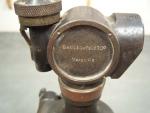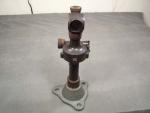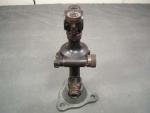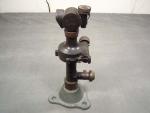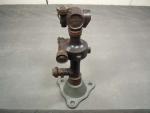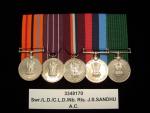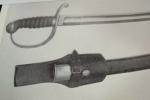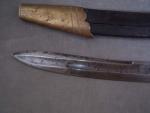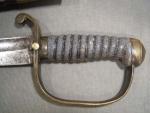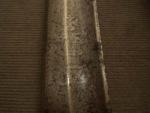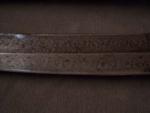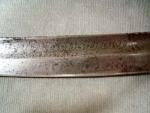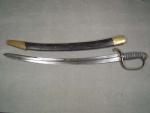-
Posts
6,486 -
Joined
-
Last visited
-
Days Won
10
Content Type
Profiles
Forums
Blogs
Gallery
Events
Store
Everything posted by Brian Wolfe
-

WW I German Artillery Panoramic Sight
Brian Wolfe replied to Brian Wolfe's topic in Armour, Vehicles, Ships & Aircraft
-

WW I German Artillery Panoramic Sight
Brian Wolfe replied to Brian Wolfe's topic in Armour, Vehicles, Ships & Aircraft
-

WW I German Artillery Panoramic Sight
Brian Wolfe replied to Brian Wolfe's topic in Armour, Vehicles, Ships & Aircraft
-

WW I German Artillery Panoramic Sight
Brian Wolfe replied to Brian Wolfe's topic in Armour, Vehicles, Ships & Aircraft
-
Hello Everyone, On the weekend I was captured and forced on a death march through a large flea market in Grand Bend Ontario. After 219 miles of endless knock-off sweaters and 600,000 purses, JUST BUY ONE FOR GOD'S SAKE WOMAN!!!!!!! , we came upon this cool artillery sight. My wife took pitty on her long suffering husband and purchased it for me for $90.00 which may or may not have been a good deal. Considering the shopping anguish factor it was a good price, well at least it kept me happy...smart woman. I believe this is for the 7.7cm Leichte Feld Kanone model 1896 and used throughout WW I on German Artillery pieces. I have seen very similar periscopes made by the Soviets and used during WW II. There are some differences and the Soviet ones are clearly marked with the hammer and sickel. I am asking for opinions as to when this was made. In the second photo you can see the letters and numbers S.M.W. 3266 engraved in a hand printed style on the side of the scope. In later production this area is stanped with the date, such as 1916, 1917 etc. From other items I have seen when you encounter this engraved style it usually indicates an early manufacture. Could this have been made before WW I or perhaps very early in the war before they switched to the faster method of stamped numbers? There are no military marking on this what-so-ever. The optics are still quite clear in this periscope and all of the dials work like new. The construction is steel with brass graduation rings. The grey base is a pipe flange that just happened to have the same threads as the sight and was probably use to deisplay the piece by the former owner, perhaps the fellow who brought this back from the war. I'll describe the markings as I post the photos. Thanks for any help you can give me. Regards Brian
-

Group to Swr./L.D./C.L.D./Nb.Ris. J.S.Sandhu AC
Brian Wolfe replied to Brian Wolfe's topic in South Asia
Hello Doc, I will indeed add to your thread, thank you for the invitation to do so. I knew you were one of the members who has an appreciation for Independent Indian medals. Bharat medals rule! Regards Brian -
Hello Everyone, I know there is limited interest in the medals of Independent India as well as South Asia in general on the forum. I usualy content myself with posting images of my Indian groups on the Collectors Image Gallery (check it out when you have absolutely nothing else to do) This group is so facinating that I had to post it now that it has been cleaned and court mounted for the membership to check out. First the medals themselves, from the viewer's left to right): Raksha Medal named to: 3348170 SWR J.S.SANDHU (showing service during the 1965 war with Pakistan) Sangram Medal named to: 3348170 LD JS SANDHU AC (showing service during the 1971 war with Pakistan) 25th Independence Anniversary Medal named to: 3384170 LD JS SANDHU AC 20 Years Long Service Medal named to: 3348170 NB RIS J S SANDHU AC 9 years Long Service Medal named to: 3348170 CLD Y S SANDHU AC (note the error in his first initial of "Y" rather than the correct letter "J") Now to the ranks: SWR means Sowar which is a cavalry rank equal to a Sepoy in the Indian Infantry or a Private here in the western world. LD means Lance Daffadar, a cavalry rank equal to a Lance Naik in the Indian Infantry or a Lance Corporal in the west. CLD is Company Lance Daffadar (see above but add "Company") NB RIS is Naib Risalder or "Rissaldar" in the British Indian Army and is a cavalry rank equal to a Naib Subedar in the infantry or something like a Sub Lieutenant in the west. A Rissalder was also know as a Jemadar in the British Indian Army and is a Junior Commissioned Officer (JCO) in the post 47, or Independent, Indian Army. Risaldar means the commander of a Risala (mounted troup) in the Persian language and is a mid-level rank in the cavalry and armoured units of the Indian Army. Risaldars generally command squadrons. What is interesting about this group is the rise from a Private (Sowar) through the ranks to a Junior Commissioned Officer rank of a Sub Lieutenant (Naib Risalder). Not that this is unheard of but rather that it is not common for the move through the ranks to be so well documented in a group. As stated above he served through the two principal wars with Pakistan but the absence of combat stars would suggest to me that his role was more supportive in nature during these times. True there may have been combat stars that have been lost and what a group that would have made! I also found it interesting that his regimental number of 3348170 never changed even though he attained the rank of a Junior Commissioned Officer. Other groups in my collection that show a move up the ranks also show a change in the number which will then start with the letters JC. You can see some of these if you visit my Collectors Image Gallery. I hope you like the group and I have not put you to sleep with my long article. Regards Brian
-

Imperial Russia IMPERIAL RUSSIAN PILOTS BADGE 1917
Brian Wolfe replied to arrestanddevelopment's topic in Russia: Imperial
Not that I'm an expert by any means but I never even knew these existed. Perhaps I need to get out of "India" more often. Thanks for sharing what must be a very rare item. Regards Brian -
For a good tooth brush for cleaning almost anything I suggest that you go to the pharmacy or chemist or drug store (whatever you call it in your area of the world) and purchase a tooth brush used for cleaning dentures (false teeth)these are too hard for your own teeth but ideal for dentures (or so I am told). I found out about them when I collected fossils. The more they wear down the "stiffer" the bristles become and the better they work. Here's a photo of the one I use as you can see 40 years of cleaning fossils, minerals and military items has taken its tole. Regards Brian
-
Hello Kenneth, Ah the smell of cosmoline, we used to refer to it as axel grease and military rifles used to come "packed" in this stuff. The NCO sword is not hand made but rather mass produced. One would have to worry more about the hand-made blades as there is a chance that anything you use could penetrate between the folded layers of the steel. In the case of the NCO this is not an issue. Use mineral spirits to clean off the cosmoline. Actually I have used lacquer thinner and that works very well but is not very nice to work with, and quite flammable. If you can disassemble the sword before you start that is best as then the mineral spirits will not run into the handle assembly. To protect the blade afterwards use a good paste wax. This is NOT advisable on a hand-made blade but on the NCO sword it will work just fine. One last thing, tell anyone who wants to "look" at the blade NOT to touch it. They will anyway but you have my permission to remove the offending hand with the second sword. Only kidding of course, you don't need my permission, it's a given. Please post photos of the swords when you can as I am sure many members (including myself) would like to see them. Regards Brian
-

Help with... a CANNON!
Brian Wolfe replied to Douglas Jr.'s topic in Great Britain: Militaria: Badges, Uniforms & Equipment
I agree that is is not military or at least not a government piece. Due to the size and shape I wonder if it could have been employed to signal the approach of a ship to the harbour etc. It looks too large to be a "rampart gun" The photos may be distorting the cannon a bit but I'm thinking it is a private purchase use to signal. This is a pure guess of course. Regards Brian -

A RARE BOER WAR MEDAL
Brian Wolfe replied to Mervyn Mitton's topic in Great Britain: Orders, Gallantry, Campaign Medals
Hi Mervyn, That's a great medal and many thanks for the history lesson as well. I always like to see some history along with the medal or other item. Perhaps this will start others researching their items and sharing their knowledge along with their collection. Regards Brian -
To round out this post and give it the "Swords 101" treatment here is a photo from the book noted earlier showing the suspension device used on the original "hangers" from which I suspect the name of this style of sword was derived. Regards and thanks for "hanging" in there until the end of my post. That's "nerd" humour. Regards Brian
-
This sword would have been suspended by a leather frog through which a sword belt would run. I did not show this side of my sword but the frog stud is intact. This photo comes from the "Swords & Daggers" book referenced earlier in this post. This style of frog is seen on many, if not all, older bayonet scabbards,
-
Here is a shot of the hilt. You can see the release button and the ray skin grip. Ray skin is white in its raw state and you will see white ray skin use on many Japanese edged weapons. In cases such as this the raw ray skin is dyed from the back and then the surface bumps are ground off to produce the white-topped bumps. If the grinding is done until the surface is smooth the finished product has a pattern that looks like small circles. This is often used on jewellery boxes and other decorative items. The tang of the blade runs through the grip and is penned over where it comes out through the pommel. This is indicative of massed produced swords rather that the tang being threaded and a threaded button attached at the end of the pommel, though mass production could also see the button used I think the more expensive swords would not have the tang end penned over as is the case here.
-
Hello Everyone, I am very excited to be adding a police sword from the Victorian period for Staffordshire Constabulary to my collection. The sword is 73cm overall with a 59cm curved blade which is etched "STAFFORDSHIRE No. 140 CONSTABULARY" plus Queen Victoria's crown over the Staffordshire knot. The hilt is brass and has a release button to lock the sword into the scabbard. The grip is shagreen rayskin probably from the Pearled Ray (Hypolophus sephen). The grip has not been wire wrapped as is sometimes found on rayskin grips. The scabbard is leather with brass fittings. This type of sword is called a "hanger". The hanger, sometimes called a hunting sword, is a short sword similar to a cutlass that was used by woodsmen and soldiers in the 17th and 18th centuries. These small swords were worn supported on two chains of differing lengths suspended from a steel hook which was slipped over a belt or waist band [the term "hanger" may have come from this method of suspension and the term then became associated to the swords themselves]. Research on hangers comes from "Swords and Daggers" by Federick Wilkinson, Ward Lock & Co. Limited, London and Sydney, second printing 1969. Now for some photos.
-

Working on recreating Saddam's Medal Bar
Brian Wolfe replied to Riley1965's topic in Middle East & Arab States
Hi Doc, I've been following this thread for some time now and while it is not within the area of my collecting I am interested in seeing such items as this recreated. I've thought of doing this sort of thing myself but ambition is not running too deeply with me at the moment. It's good to see the progress you've made and I look forward to the end result. Regards Brian -

My collection of India Police (Special Duty) medals
Brian Wolfe replied to Brian Wolfe's topic in Police Forces of the World
Hi Mervyn, I guess it is a bit strange for a fellow in Canada to collect the medals of India. It all started with British medals such as the India General Service Medals to Indian recipients, then...well you know how it goes. I do like your idea of an index of some sort. I've found it difficult to go back through the posts looking for research material or trying to find a particular post that I barely remember but know is here. There is a search engine (I hope that is the correct term) that you can use but it is not an index. I will be interested in how this turns out. Regards Brian -
Hello Mike, Nice display. I like the idea of using the repro tunic material in the bottom, nice touch. Regards Brian



